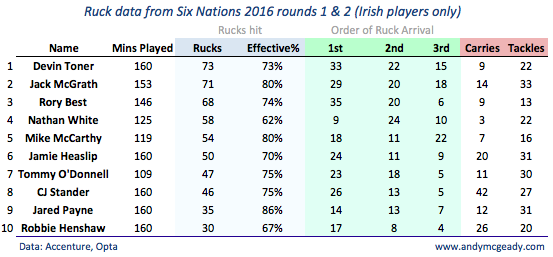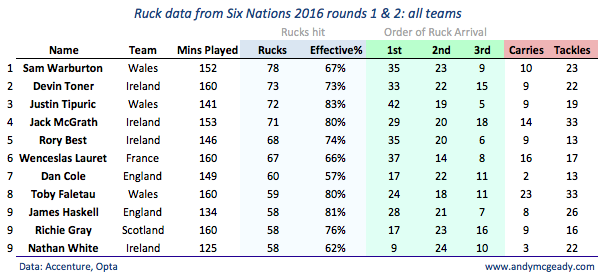Rucks and ruck data, rugby’s world of the unseen
Rucks and ruck data. I’ve brought you here before, but it’s always welcome.
Rugby’s not an easy game for a stats-friendly parish. Difficult to code at speed, harder still to do so accurately. So when we got a whiff of individual ruck data being available for the Six Nations, the doors were thrown open. Welcome, we said. And no surprise to see Welsh captain Sam Warburton hitting most rucks. But does that mean he was most effective?
The stats we see on Six Nations television screens are part of a live coding feed, supplied by Accenture and originally generated by Opta.
Then there’s a post-match feed where things are ironed out; a player’s tackle stats adjusted for example. Ruck stats are another level of detail again. It’s not an expected part of a post-match stats sheet presented to media straight after a game. It takes too much effort, too much time. So you won’t see it in match reports.
This column has discussed ruck data before; part of rugby’s world of the unseen. Getting it is nice. Hell, it’s great. But it is odd to examine that data at the same time as questioning whether Ireland’s reliance on that part of the game is the right way to go about things. Surely better to gain ground by avoiding contact rather than build a game-plan around seeking it?
Before going too far down that philosophical rabbit hole it’s worth noting a simple truth: it’s better to be good at something than bad. That’s where the notion of ruck “effectiveness” comes in. In attacking terms: clearing out a poacher or securing the breakdown. In defence: getting into strong positions that slow down the opposition attack, poaching ball outright, or forcing a penalty. Ineffectiveness? Well that’s the opposite; arriving but not clearing out, or being cleared out, or conceding a penalty, or not doing very much at all. It applies a measure of quality to the raw quantitative figure. Order of arrival tracks if a player was the first, second or third (or fourth or fifth) from their team to arrive at the breakdown after a tackle is made.

Definitions differ between providers, and, while some things are easily counted, a qualitative assessment of a player’s ruck actions can be in the eye of the beholder. Team video analysts will have different definitions again – based on their needs and the playing philosophies of their coaching team – as they supply qualitative ratings for many parts of a player’s game, including quality of carry, making or taking contact, and ball presentation.
Disclaimers in place, with so many rucks in the modern game it’s reasonable to include raw numbers of rucks hit as a statistic to help provide an approximation of a player’s work rate. This is especially true when it comes to clearout artists and piano-shifters whose work can be hidden.

As mentioned, no surprise to see Warburton atop the list. But it’s a little surprising to see him rated as being ineffective at the breakdown one third of the time over the competition’s first two rounds. Compare Warburton’s 67 per cent to his dropped team-mate Justin Tipuric’s 83 per cent, for example, or the 73 per cent average of the entire Six Nations player pool. For players who’ve hit 35 rucks or more in the first two games the highest mark was 86 per cent, shared by Luke Charteris and Jared Payne.
Having presented those stats, we will not draw grand conclusions. It’s just two rounds of games, a small sample. More data would be better, for more games, and more quickly. Some day could these things could get easier?
At a sports analytics conference in London recently this column caught up with a man of experience in sports analytics. A clever man. We discussed the player tracking data now used by the NFL but not yet released to teams. NFL fans might have seen video-game style graphics that the technology can generate. The NFL’s system, from Zebra Technologies, uses RFID (Radio Frequency Identification Device), not cameras. This is important because of the problem that is occlusion, the difficulty in tracking multiple overlapping objects moving through space. When players merge into a big pile of bodies, distinct shape is lost; optical tracking gets hard.
In some future rugby analysis nirvana there will be optical tracking data, RFID chips and manual coding of on-the-ball action. The data will be instant and complete. In the absence of that ideal, we make do with that we can get. More ruck data, please.

its very good data but the irish arent a good enough team to use as data
very good data (thumbs up)